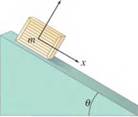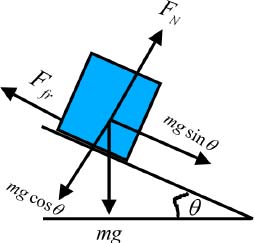
Concept explainers
The crate shown in Fig. 4-60 lies on a plane tilted at an angle
v

Figure 4-60
Part(a)To Determine:
The acceleration of the crate when it slides down an inclined plane when force of kinetic friction acts on it.
Answer to Problem 57P
Solution:
The acceleration of the crate down the inclined plane is found to be 2.5 m/s2.
Explanation of Solution
The crate of mass slides down a plane inclined at an angle to the horizontal. The free body diagram of the crate is shown below.

The weight mg of the crate acts vertically downwards. The normal force acts perpendicular to the inclined plane. The weight mg is resolved into two components, parallel and perpendicular to the inclined plane. The force of kinetic friction acts opposite to the direction of motion of the box. There is a net force acting on the box in the downward direction parallel to the inclined plane accelerating it at a rate a.
Since there is no motion perpendicular to the incline,
…… (1)
The force of kinetic friction is related to the normal force as,
…… (2)
Since the crate slides down the incline, there is a net force F that acts downwards. This is given by,
…… (3)
Substitute equations (1)and (2)in (3).
……. (4)
From Newton’s second law,
Here, a is the resultant acceleration of the crate down the incline.
Therefore,
……(5)
Given:
The length of the incline
The angle at which the incline is inclined
The coefficient of kinetic friction
The initial velocity of the crate
Formula used:
Calculation:
Calculate the acceleration of the crate down the incline by substituting 9.8 m/s2for g and the given values for and .
Part(b)To Determine:
The speed of the crate when it reaches the bottom of the incline.
Answer to Problem 57P
Solution:
The speed of the crate at the bottom of the incline is found to be 6.3 m/s.
Explanation of Solution
To calculate the speed of the crate when it reaches the end of the incline of length s is calculated using the equation of motion,
……(6)
Given:
The length of the incline
The angle at which the incline is inclined
The coefficient of kinetic friction
The initial velocity of the crate
Formula used:
Calculation:
Calculate the speed of the crate when it reaches the bottom of the incline by substituting the calculated value of a and the given values of s and in the equation,
Chapter 4 Solutions
Physics: Principles with Applications
Additional Science Textbook Solutions
Biology: Life on Earth (11th Edition)
Human Physiology: An Integrated Approach (8th Edition)
Cosmic Perspective Fundamentals
Applications and Investigations in Earth Science (9th Edition)
Human Anatomy & Physiology (2nd Edition)
Organic Chemistry (8th Edition)
- No chatgpt pls will upvote Alreadyarrow_forwardTwo objects get pushed by the same magnitude of force. One object is 10x more massive. How does the rate of change of momentum for the more massive object compare with the less massive one? Please be able to explain why in terms of a quantitative statement found in the chapter.arrow_forwardA box is dropped on a level conveyor belt that is moving at 4.5 m/s in the +x direction in a shipping facility. The box/belt friction coefficient is 0.15. For what duration will the box slide on the belt? In which direction does the friction force act on the box? How far will the box have moved horizontally by the time it stops sliding along the belt?arrow_forward
- Plz solution should be complete No chatgpt pls will upvote .arrow_forwardA box with friction coefficient of 0.2 rests on a 12 foot long plank of wood. How high (in feet) must one side of the plank be lifted in order for the box to begin to slide?arrow_forwardWhat is a good general rule to follow in order to find the best choice of coordinate system to solve a dynamics problem?arrow_forward
- What is the meaning of a first order approximation?arrow_forwardNo chatgpt pls will upvote Already got wrong chatgptarrow_forwardA hydrogen atom has just a single electron orbiting the nucleus, which happens to be a single proton without any neutrons. The proton is positively charged, the electron negatively, but both with the same magnitude of charge given by e=1.602x10-19C. The mass of an electron is 9.11x10-31kg, and the proton is 1.67x10-27kg. Find the ratio of the electrostatic to the gravitational force of attraction between the electron and the proton in hydrogen. \arrow_forward
 College PhysicsPhysicsISBN:9781305952300Author:Raymond A. Serway, Chris VuillePublisher:Cengage Learning
College PhysicsPhysicsISBN:9781305952300Author:Raymond A. Serway, Chris VuillePublisher:Cengage Learning University Physics (14th Edition)PhysicsISBN:9780133969290Author:Hugh D. Young, Roger A. FreedmanPublisher:PEARSON
University Physics (14th Edition)PhysicsISBN:9780133969290Author:Hugh D. Young, Roger A. FreedmanPublisher:PEARSON Introduction To Quantum MechanicsPhysicsISBN:9781107189638Author:Griffiths, David J., Schroeter, Darrell F.Publisher:Cambridge University Press
Introduction To Quantum MechanicsPhysicsISBN:9781107189638Author:Griffiths, David J., Schroeter, Darrell F.Publisher:Cambridge University Press Physics for Scientists and EngineersPhysicsISBN:9781337553278Author:Raymond A. Serway, John W. JewettPublisher:Cengage Learning
Physics for Scientists and EngineersPhysicsISBN:9781337553278Author:Raymond A. Serway, John W. JewettPublisher:Cengage Learning Lecture- Tutorials for Introductory AstronomyPhysicsISBN:9780321820464Author:Edward E. Prather, Tim P. Slater, Jeff P. Adams, Gina BrissendenPublisher:Addison-Wesley
Lecture- Tutorials for Introductory AstronomyPhysicsISBN:9780321820464Author:Edward E. Prather, Tim P. Slater, Jeff P. Adams, Gina BrissendenPublisher:Addison-Wesley College Physics: A Strategic Approach (4th Editio...PhysicsISBN:9780134609034Author:Randall D. Knight (Professor Emeritus), Brian Jones, Stuart FieldPublisher:PEARSON
College Physics: A Strategic Approach (4th Editio...PhysicsISBN:9780134609034Author:Randall D. Knight (Professor Emeritus), Brian Jones, Stuart FieldPublisher:PEARSON





